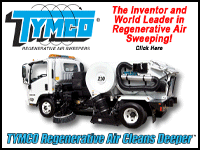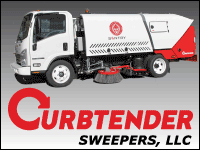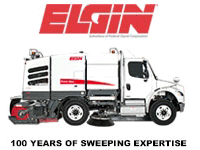"Consumer Reports" for Power Sweepers: Is the Industry Ready for That Kind of Data?
by Ranger Kidwell-Ross, editor
WorldSweeper.com
As part of a Sea Grant/NOAA-funded research project led by the City of Santa Barbara, a planned evaluation of street sweeper performance is underway to assess their ability to remove microplastics and other pollutants from stormwater washoff. Building on previous studies, the project hopes to start by assessing at least eight different makes and models of street sweepers – including mechanical broom, regenerative air, and vacuum types – using a standardized street dirt simulant enhanced with microplastics.
This approach will provide a rigorous comparison of the various types of sweepers' effectiveness in removing both microplastics and the complete range of particle sizes from street surfaces. In addition, the project, which WorldSweeper is coordinating, intends to measure dust emissions and noise levels associated with each model. The goal is to obtain a comprehensive understanding of the predicted positive environmental impact of each.
Our findings aim to inform – and potentially provide data for updating – outdated current certifications, such as AQMD's Rule 1186, which currently governs street sweeper use in Southern California based on testing methods and technologies from over 25 years ago. By generating unbiased, up-to-date "consumer reports" on sweeper technology pick-up efficiency, our research will offer stormwater professionals nationwide valuable data to guide the selection of equipment that maximizes pollutant removal.
WorldSweeper will, of course, also be providing the data to our readers and elsewhere. We have every expectation that the results will show that all three types of standard sweeping technology will be a more cost-effective way to remove pavement-based pollutants than any other method. Air sweepers will likely still be shown to be the most cost-effective way to remove small micron particles, which have been shown to be closely linked to greater pollutant concentrations in stormwater when compared to any other non-sweeping technology.
However, broom sweepers serve many specialty sweeping functions and may show an ability to adequately remove microplastics, which is the primary focus of the planned testing. Later this year we will share detailed results along with discussing their implications for stormwater management and regulatory policy.
In the meantime, be sure to keep involving your communities in ways that showcase street sweeping and emphasize the environmental value it provides. After all, pavement sweeping has been shown again and again to be "the first line of defense for pavement-based pollution removal!"
If you are one of WorldSweeper's advertising sponsors, thank you for the critical part you play in supporting 'Earth's Largest Power Sweeping Resource.' I am honored by your collective votes of confidence in what this organization provides to the power sweeping industry.
Likewise, if you are one of the industry suppliers providing WSA Members with savings on your goods and services, thank you for providing those WSA Member Benefits. Finally, if you sell to the sweeping industry but don't yet advertise with us, please consider doing so.
Good Sweeping,

Editor, WorldSweeper.com
Executive Director, World Sweeping Association
Member, PAVEMENT Hall of Fame
PS If you're a contractor I urge you to check out the many benefits of membership in the World Sweeping Association. Also, if you haven't 'liked' our WorldSweeper Facebook page, what are you waiting for? That's where we offer a variety of industry previews and updates on an ongoing basis.

May/June Newsletter Contents
(Scroll down to read stories or click on links below.)
- Update on Process Behind This Summer's Sweeper Testing
- Street Dust: Implications for Stormwater and Air Quality, and Environmental Management Through Street Sweeping
- New York City Moves to Automate Alternate Side Parking Enforcement with Sweeper Cameras
- The Power of Community Engagement in a Street Sweeping Program
- Free Webinar on the 2025 ASCE Infrastructure Report Card for Stormwater
- Determining the Best Hopper Size for a Cleaner Community
Update on Process Behind July's Planned Sweeper Testing
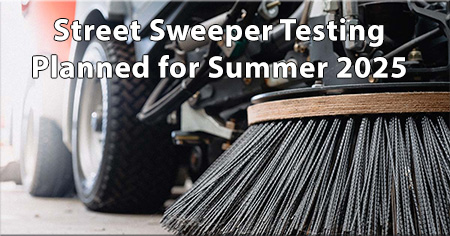
In each of our 2025 WorldSweeper newsletters we have discussed the street sweeper testing process that will occur starting in mid-July as part of a Sea Grant/NOAA project administered through the City of Santa Barbara. However, even though we have held informational webinars and provided manufacturers and others about the value the test results could provide, which could spur significant expansion of the power sweeping industry as a whole, securing manufacturer test participation has been challenging. That is true even though previous statistically significant research conducted in Minnesota and Florida have shown street sweeping to be up to a 700% more cost-effective way to remove pavement-based pollutants than any other method or Best Management Practice (BMP).
Even though testing has been offered at no charge, to date only Fayat Environmental Solutions, widely recognized as the largest street sweeper manufacturer in the world and maker of Ravo, Mathieu, Scarab and Dulevo branded sweepers, has taken us up on the offer. I speculate that one of the reasons for testing reluctance by other manufacturers is that they all found a way to pass the 25+ year old test put on by the South Coast Air Quality Management District (SCAQMD), which was conducted at a time when Fayat was not yet selling in the U.S. The rest may not want to 'upset the apple cart' of their current certification by SCAQMD, which allows them to sell into SCAQMD's large California market area.
Unless we can convince other manufacturers to test by our mid-July testing dates, the sweepers that will be tested will have to be rented from LA-area municipalities and contractors instead of being new or demo models provided directly by the manufacturers. Because they aren't in new condition, this may negatively affect results that will ultimately be peer-review published, as well as provided to the stormwater community and elsewhere, to show the 'first line of water quality defense' street sweepers can actually provide. The sweeping industry – including purchasers around the U.S. – deserve better. We hope that ultimately the other sweeper manufacturers will understand the potential well enough to participate directly.
Use this link to see a PDF file we generated that discusses the value of this test to the greater power sweeping community.
Street Dust: Implications for Stormwater and Air Quality, and Environmental Management Through Street Sweeping
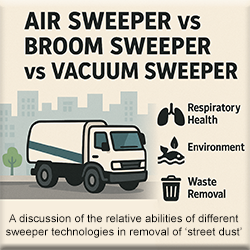
Street dust is comprised of particles from motor vehicles (tire debris, emissions), local soils, pavement wear, maintenance sand or road salt, organic debris, and anthropogenic trash. These materials often contain contaminants such as metals, organic pollutants (e.g., PAHs), and nutrients, especially in fine particles (<250 µm), which are readily mobilized by runoff or re-suspended into the air. Street dust thus poses significant risks to both stormwater and air quality.
The link below is to a summary of a study conducted and published in 2015. WorldSweeper hadn't become aware of it until 2025. Of course we also include a link to the actual study. Note that one of the people who conducted the research, Steven Calvillo, has been an advisor with the TYMCO organization for the last 17 years.
Check out the information.
New York City Moves to Automate Alternate Side Parking Enforcement with Sweeper Cameras
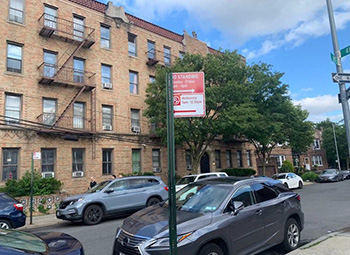
In a push to make New York City's streets cleaner and safer, the NYC City Council has voted overwhelmingly to support a state bill that would allow the installation of cameras on Department of Sanitation (DSNY) street sweepers to automatically ticket vehicles that violate alternate-side parking rules.
The proposed legislation – known as S1891 in the Senate and A4523 in the Assembly – would authorize cameras to photograph and then cause summonses to be sent to owners of cars parked along the curb during scheduled street cleaning hours, streamlining enforcement and targeting repeat offenders.
Check out the NYC proposal
The Power of Community Engagement in a Street Sweeping Program
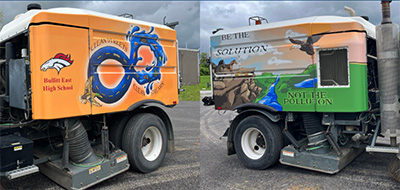
Municipal street sweeping is a frontline defense for urban water quality and environmental health, yet its success hinges not just on equipment and schedules, but on the active participation and understanding of the community. Engaging citizens – especially youth – in these programs transforms routine maintenance into a shared civic mission, amplifying environmental awareness and fostering a culture of stewardship.
Two core strategies drive community engagement: educating the public, particularly children, about the environmental impact of street sweeping, and using creative outreach – such as naming contests and art projects – to make these efforts visible, relatable and supported. When residents understand why it matters to move their cars for sweepers or celebrate a newly wrapped vehicle, they become allies in keeping streets and waterways clean.
Learn more about the concepts.
Free Webinar on the 2025 ASCE Infrastructure Report Card for Stormwater

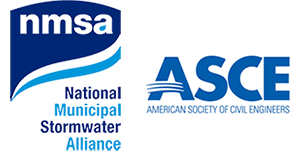
The National Municipal Stormwater Alliance (NMSA) and the American Society of Civil Engineers (ASCE) are co-hosting a webinar on the 2025 ASCE Report Card for Stormwater from 2-3:30pm (Eastern) on Tuesday, June 17, 2025.
The first ASCE Infrastructure Report Card(tm) that included a grade for the stormwater sector was released in March 2021 with a grade of D. This inclusion of stormwater in the Infrastructure Report Card was a major milestone in the stormwater sector as it reflects the rising awareness of stormwater issues and recognition that the stormwater sector has significance on par with other infrastructure sectors. The second Infrastructure Report Card, which includes a grade for stormwater, was released in March 2025. It reinforces the ongoing acknowledgement of the significance of stormwater management in the U.S.
This webinar will bring together stormwater professionals to provide an overview of the 2025 Infrastructure Report Card grade for stormwater. Details will be shared on specific Report Card criteria, such as Funding and Future Need, Operation and Maintenance and Resilience, with on-the-ground experiences and information presented to color these aspects of the Report Card. 1.5 PDHs will be offered in association with this webinar. Use the link shown below to register for this free event. It will be recorded and posted for free at the NMSA YouTube channel and the link to this channel will be provided to all who register.
Register for the webinar.
Determining the Best Hopper Size for a Cleaner Community
In addition, Elgin has announced the expansion of Joe Johnson Equipment into new territories in Indiana and Louisiana.

Street sweeping is an essential part of keeping municipalities clean year-round. Effectiveness can be affected by both the type of sweeper used and the hopper capacity offered. Elgin Sweeper offered us an overview on the types of information that should be considered when choosing hopper size.
In addition, you can use the other link below to check out where Federal Subsidiary's Joe Johnson has expanded to recently.
Take a look at the information offered about hopper size. Use this link to find out more about the Joe Johnson expansion into Indiana and Louisiana.
|
